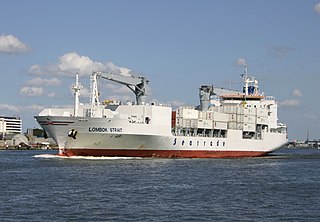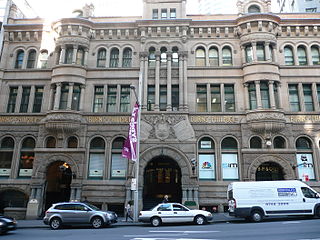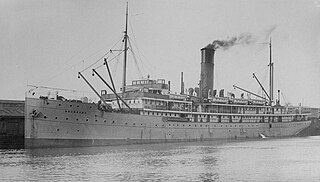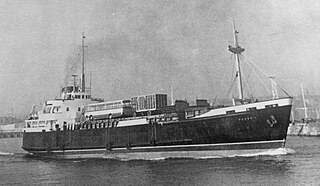
A container ship is a cargo ship that carries all of its load in truck-size intermodal containers, in a technique called containerization. Container ships are a common means of commercial intermodal freight transport and now carry most seagoing non-bulk cargo.

Mitsui O.S.K. Lines is a Japanese transport company headquartered in Toranomon, Minato, Tokyo, Japan. It is one of the largest shipping companies in the world.
A cargo ship or freighter is a merchant ship that carries cargo, goods, and materials from one port to another. Thousands of cargo carriers ply the world's seas and oceans each year, handling the bulk of international trade. Cargo ships are usually specially designed for the task, often being equipped with cranes and other mechanisms to load and unload, and come in all sizes. Today, they are almost always built of welded steel, and with some exceptions generally have a life expectancy of 25 to 30 years before being scrapped.

A reefer ship is a refrigerated cargo ship typically used to transport perishable cargo, which require temperature-controlled handling, such as fruits, meat, vegetables, dairy products, and similar items.

Burns Philp was once a major Australian shipping line and merchant that operated in the South Pacific. When the well-populated islands around New Guinea were targeted for blackbirding in the 1880s, a new rush for labour from these islands began. James Burns and Robert Philp purchased several well-known blackbirding ships to quickly exploit the human resource in this region, and Burns Philp entered the slave trade. The company ended its involvement in blackbirding in 1886. In later years the company was a major player in the food manufacturing business. Since its delisting from the Australian Securities Exchange in December 2006 and the subsequent sale of its assets, the company has mainly become a cashed up shell company. It is wholly owned by Graeme Hart's Rank Group.

The Isles of Scilly Steamship Company (ISSC) operates the principal shipping service from Penzance, in Cornwall, to the Isles of Scilly, located 28 miles (45 km) to the southwest. It provides a year-round cargo service together with a seasonal passenger service in summer. The name of the company's principal ferry, the Scillonian III, is perhaps better known than that of the company itself.

The Illawarra Steam Navigation Company was a shipping company that serviced the south coast of New South Wales, Australia from 1858 to the early 1950s. It was formed through the amalgamation of the General Steam Navigation Company, the Kiama Steam Navigation Company and the Shoalhaven Steam Navigation Company, each of whom serviced parts of the south coast with their respective vessels. After merging, the new company held a near monopoly in regard to shipping on the south coast, and their fleet visited every significant port between Sydney and the border of Victoria. The company transported both passengers and a range of produce, including livestock, and hence it became known as the 'Pig and Whistle Line': it was said that ships would wait an hour for a pig but not a minute for a passenger.

SS Koombana was a late Edwardian-era passenger, cargo and mail carrying steamship. From March 1909 to March 1912, she operated coastal liner services between Fremantle, Western Australia and various ports in the northwest of that state. She is best known for disappearing at an unknown location north of Port Hedland, Western Australia, during a tropical cyclone on 20 March 1912, killing 74 passengers and 76 crew; in total, 150 people died.

Fremantle Harbour is Western Australia's largest and busiest general cargo port and an important historical site. The inner harbour handles a large volume of sea containers, vehicle imports and livestock exports, cruise shipping and naval visits, and operates 24 hours a day. It is located adjacent to the city of Fremantle, in the Perth metropolitan region.

Christensen Canadian African Lines (CCAL) was a Norwegian cargo shipping company that traded between Canada and Africa between 1948 and 2000.

SS Ferret was an iron screw steamship of 460 tons built in Glasgow (Scotland) in 1871 by J & G Thomson, Glasgow.

The Adelaide Steamship Company was an Australian shipping company and later a diversified industrial and logistics conglomerate. It was formed by a group of South Australian businessmen in 1875. Their aim was to control the transport of goods between Adelaide and Melbourne and profit from the need for an efficient and comfortable passenger service. For its first 100 years, the company's main activities were conventional shipping operations on the Australian coast, primary products, consumer cargoes and extensive passenger services.

The Indo-China Steam Navigation Company, Limited (ICSNC), was established in 1873 as a subsidiary of Hong Kong based Jardine, Matheson & Co., one of the largest trading companies in the Far East at that time.

MV Ramsey was a coastal cargo vessel built for the Isle of Man Steam Packet Company in 1964. She was the last vessel specially built to serve the smaller ports of the Island.

MV Peveril was a coastal cargo vessel operated by the Isle of Man Steam Packet Company. Peveril, the third ship in the Company's history to bear the name, was built by Ailsa Shipbuilding Company at Troon, Scotland, in 1964.
The State Shipping Service of Western Australia was a state government transport entity formed in 1912, in Western Australia, primarily to service the ports of North West Australia.

Dona Nati was one of three identical cargo ships built in 1939 by Cantieri Riuniti dell'Adriatico, San Marco, Trieste, Italy, for the De la Rama S.S. Co. Inc., Iloilo, Philippines, intended for service between the Philippines West Coast and North America. The ship was engaged in normal commerce until it became a key player in events in the Philippines after December 7, 1941, and the Japanese invasion of the islands. Dona Nati had arrived in Manila along with the ships President Grant, John Lykes, Cape Fairweather, and American Leader in a convoy escorted by the USS Boise (CL-47) on December 4, 1941. She had escaped to Australia where she became particularly notable as being one of only three ships to successfully run the Japanese blockade in attempts to supply the forces cut off in the Philippines. The ship was retained under Army control and on April 28, 1943, was one of twenty-eight vessels forming the fleet available to the Southwest Pacific command under General MacArthur.

MV E Evangelia is a shipwrecked 7,355-gross register ton (GRT) refrigerated cargo ship at Costinești on the Black Sea coast of Romania. She was built in Northern Ireland in 1942 as the Empire ship Empire Strength, was operated by Blue Star Line from 1942 to 1961, was bought by Greek shipowners in 1965 and wrecked in 1968. The ship had four names in her career, having been renamed Saxon Star in 1946, Redbrook in 1961 and E Evangelia in 1965.
John Ralph Hansford Ward, invariably known as Hansford Ward or Captain Ward, was a ship's captain in South Australia, who figures prominently in the pre-history of the Adelaide Steamship Company. A son, also named John Ralph Hansford Ward but known as John R. H. Ward, was also a ship's captain.















